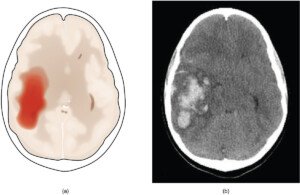
Do you have a relative just diagnosed with a brain aneurysm and are wondering if you should get a screening MRI every year?
There is a type of brain aneurysm called familial aneurysm. And it’s called that for a reason: It tends to run in families.
The term cerebral aneurysm refers to a dilated blood vessel in the brain. It does not refer to a rupture.
Another name for this condition is intracranial aneurysm (IA). When these dilated blood vessels rupture, they are then called “ruptured” or aneurysmic subarachnoid hemorrhage (aSAH).
So when someone “has an aneurysm” and dies, this is actually an incorrect description. They had a ruptured aneurysm.

Shutterstock/OpenStax College
Which Relatives of Someone with Brain Aneurysm Should Have Screening MRI?
Recommendations by the treating physician of the relative with an aneurysm will depend on if the dilated blood vessel is deemed familial or sporadic.
It may also depend on if it has ruptured.
“In individuals with a family history of aSAH, the yield of long-term screening is substantial even after more than 10 years of follow-up and two initial negative screens,” says a study in THE LANCET – Neurology, April 2014, Bor et al.
“We advocate long-term serial screening in these individuals,” continues the paper, “although the risk of aSAH within screening intervals is not eliminated.”
Screening recommendations of relatives of people with a brain aneurysm are not carved in stone and will vary from one study to another.
It is a well-established fact that when someone learns they have a brain aneurysm, as a result of a screening MRI triggered by a relative’s newly diagnosed aneurysm (ruptured or not), the ensuing anxiety is substantial.
After all, you’re walking around with new knowledge that something inside your head might burst and kill you.
Usually, unruptured cerebral aneurysms are discovered by accident, when the patient undergoes imaging for an unrelated issue.
A relative will then wonder if they, too, have the condition. If their first MRI is negative it still makes sense for them to wonder if they should get repeat screening MRIs.
“It is our recommendation to offer screening, using MR or CT angiography to the first-degree relatives of patients with aneurismal SAH, particularly those patients more than 30 years of age, smokers, have a history of hypertension or of female gender,” says a report in the Saudi Journal of Medicine & Medical Sciences, 2016, Al-Jehani et al.
So if one’s relative suffered a rupture, this certainly makes the recommendation for screening MRI much stronger.
“The screening examinations should be repeated every 5-10 years to rule out latent development of aneurysms in these first-degree relatives,” continues the SJMMS.
The physician treating the patient may recommend the screening MRI only for relatives at high risk.
Like the SJMMS paper, a paper in Cerebral Vascular Disease, April 2014, points this out:
“Given the high morbidity and mortality associated with aneurysm rupture, screening for unruptured aneurysms is generally recommended for high-risk patients (at least two first-degree relatives with aneurysms, and patients with autosomal dominant polycystic kidney disease).”
What if you have only one first-degree relative with an aneurysm? The CVD report says that screening may be considered, following discussion of the benefits and risks of imaging.
There is no radiation risk of MRI screening, as it does not yield radiation exposure like a CT scan would.
However, “risk” may be in the form of anxiety. For some people, anxiety would be amplified with serial screenings, even if they’re several years apart.
And then there are those who’d take the gamble that repeated MRI screenings would be negative, yielding great reassurance of normal brain vascularity.
On the other hand, the complete absence of screening would magnify anxiety for some individuals—bringing on that “never knowing” component.
And here’s one more, from the Journal of Neurosurgery, June 2008, Brown et al:
“…among the affected patients’ FDRs [first-degree relatives] who are > 30 years of age, those who are women or who have a history of smoking or hypertension [high blood pressure] are at increased risk of suffering an IA and should be strongly considered for screening.”









































